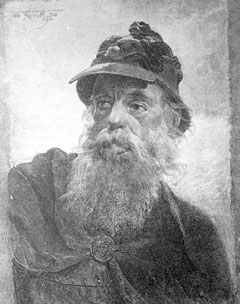
Summary
The siege of Pemaquid (August 2–3, 1689) was a successful attack by a large band of Abenaki Indians on the English fort at Pemaquid, Fort Charles, then the easternmost outpost of colonial Massachusetts (present-day Bristol, Maine). The French-Abenaki attack was led by Jean-Vincent d'Abbadie de Saint-Castin and Father Louis-Pierre Thury and Chief Moxus.[4] The fall of Pemaquid was a significant setback to the English. It pushed the frontier back to Casco (Falmouth), Maine.[5]
| Siege of Pemaquid (1689) | |||||||
|---|---|---|---|---|---|---|---|
| Part of King William's War | |||||||
 Baron Jean-Vincent d'Abbadie de Saint-Castin | |||||||
| |||||||
| Belligerents | |||||||
|
Acadia Abenaki | New England | ||||||
| Commanders and leaders | |||||||
|
St. Castin and Father Louis-Pierre Thury Chief Moxus | Lieutenant James Weems | ||||||
| Strength | |||||||
| 100 to 300[1] | 18 to 30[2] | ||||||
| Casualties and losses | |||||||
| unknown | Possibly a total of 80 from both sides.[3] | ||||||
Siege edit
The fort at Pemaquid was under the command of Lieutenant James Weems and was significantly under strength after most of its garrison had deserted in the wake of the revolt and overthrow of Governor Edmund Andros at Boston, Massachusetts earlier in the year. The complement of soldiers was reduced to thirty and many of these were in a mutinous state. The Indian force surrounded the fort, capturing or killing most of the settlers in the countryside about the fort. Lieutenant Weems provided a defense for a day, but after taking heavy casualties (Weems and 23 of the garrison having been wounded), he surrendered. The Abenaki allowed Weems and his men to return to Boston.[6] On August 4, the Abenaki burned the fort and the nearby settlement of Jamestown.
Aftermath edit
Massachusetts responded to the raid by sending out 600 men to the border region. Led by Major Jeremiah Swaine of Reading, Massachusetts, the soldiers' met on August 28, 1689 and then scoured the region. The natives killed 10 of Swaine's men at Falmouth. Despite Swaine's presence, the natives attacked Oyster River (Durham, New Hampshire) and killed 21 and taking several captive. Swaine was then replaced by Major Benjamin Church.[8]
One of the captives the Maliseet took back to their main village Meductic, on the Saint John River was John Gyles, who created one of the few captivity narratives to come out of Nova Scotia/Acadia. John's other brother Thomas escaped the siege. John Gyles' third brother James was also captured at the same time by the Penobscot and eventually taken back to Fort Pentagouet (present-day Castine, Maine) where he was tortured and burned alive at the stake.[9][10][11]
The Fort at Pemaquid was rebuilt in stone in 1692–93 and renamed Fort William Henry. Four years later d'Abbadie de Saint-Castin and the Wabanaki Confederacy captured it again.
See also edit
References edit
- ^ Parkman,Francis. France and England in North America, Volume II. The Library of America, New York, NY, 1983. p. 165-166. (Note: Parkman states 100. English accounts indicate between 200 and 300
- ^ Parkman,Francis. France and England in North America, Volume II. The Library of America, New York, NY, 1983. p. 165-166. (Note: Parkman states 30 men along with Liet. James Weems defended the fort based on a certificate in the archives of Massachusetts listing the defenders. Governor Andros stated 18 men defended the fort. Weems' list has been brought into question as it may have been compiled in order to receive a grant in repayment for moneys he advanced to his soldiers.)
- ^ Parkman,Francis. France and England in North America, Volume II. The Library of America, New York, NY, 1983. p. 165-166.(Note: La Mote-Cadillac stated eighty were killed on both sides but this may be an exaggeration.)
- ^ Drake. The Border Wars of New England. p. 28
- ^ Conquering the American wilderness: the triumph of European warfare in ... By Guy Chet, p. 81
- ^ Webster, John Clarence. Acadia at the End of the Seventeenth Century. Saint John, NB, The New Brunswick Museum, 1979.
- ^ In Castine, Maine, a plaque on Dyce Head Lighthouse Rd. says: UPON THESE HEIGHTS, in 1692, James Giles [brother of John Gyles], a boy, and an Englishman, taken at Casco [initially taken in the Siege of Pemaquid (1689)], held in slavery by Madockawando for attempting to escape, were tortured by fire, compelled to eat their noses and ears and then burned to death at the stake" (See John Gyles' captivity narrative, p. 10-11).
- ^ Drake p. 37-38
- ^ Raymond, p. 23
- ^ Note in the History of Castine (p.32) author George Wheeler erroneously indicates that John's brother Thomas is tortured when he had in fact died in the attack (See John Gyles narrative)
- ^ John Gyles narrative, p. 23
Texts
- H.-R. Casgrain, Les Sulpiciens et les Prêtres des Missions étrangères en Acadie (1676–1762) (Québec, 1897), 31–48, 139–143 (extract from Thury’s account of the destruction of Pemaquid, from Charlevoix).
- John Gyles captivity narrative
- Paltsits, Victor. The Depredation at Pemaquid in August, 1689
- Relation du Combat de Caribas par M. Thury, missionaire, 1689, vol. 1 Doc. pub. a Quebec, p. 478
- Drake. The Border Wars of New England. p. 27
43°52′39″N 69°31′29″W / 43.8775°N 69.5247°W


